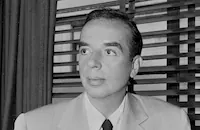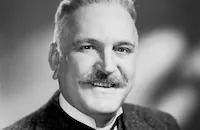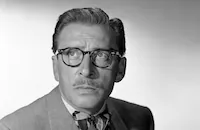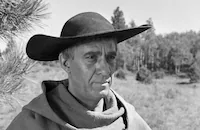Yolanda and the Thief

Brief Synopsis
Cast & Crew
Vincente Minnelli
Fred Astaire
Lucille Bremer
Frank Morgan
Mildred Natwick
Mary Nash
Film Details
Technical Specs

Synopsis
In the country of Patria, heiress Yolanda Aquaviva is celebrating her birthday and last day at the convent where she grew up. The Mother Superior explains that since she comes of age that day, she must leave the sheltered world she knows and prepare to spread kindness throughout the "other" world, where she is worth about seventy-two million dollars. Yolanda takes the train to her estate in the idyllic town of Esperando, and on the same train are Johnny Parkson Riggs and Victor Budlow Trout, embezzlers on the run from the police. As soon as they discover that Yolanda is an heiress, Johnny hatches a plan to steal her money, though Victor warns him not to because she is too beautiful and he will fall in love. Once they reach town, Johnny follows Yolanda to her gigantic estate, where Yolanda's flighty aunt Amarilla hands over control of the grounds, overwhelming her. Johnny hides in the garden just as Yolanda comes out to pray for her guardian angel to help her find her way. Another man, Mr. Candle, also strolls by, though Yolanda does not see either of them. The next day, Johnny telephones Yolanda and pretends to be "Mr. Brown," her guardian angel. He arranges for her to meet him "in human form," and makes Yolanda agree to be perfectly obedient to him. When he meets her and sees how innocent she is, Johnny feels somewhat guilty, but that night he has a nightmare in which Yolanda entices him into marriage, and this vision strengthens his resolve to swindle her. The next day he visits her and convinces her to sign a paper granting him power of attorney, and to give him one million dollars in bonds. He throws the bag with the money out the window, hitting Victor on the head and knocking him out. Candle, who is walking by, takes the bag. In a nightclub soon after, Johnny and Victor see Candle walk by with the bag, and convince him to flip a coin for it. Johnny wins and gets the money but does not trust Candle, who indeed immediately tells Aunt Amarilla that Johnny has power of attorney over Yolanda. Aunt Amarilla assumes this means that the two are to be married, and though Yolanda is scared that her guardian angel might hear this rumor and abandon her, she realizes she does have feelings for him. Johnny and Victor try to leave town right away, but they are stopped by the police and escorted back to Aunt Amarilla's costume ball, where everyone stares at Johnny, assuming he is the future Mr. Aquaviva. When Yolanda finds Johnny and asks him about the hierarchy of angels, Candle overhears, and soon after Johnny leads her in a dance into the garden. He then sadly tells her has to leave, causing Yolanda to kiss him and run away. That night, he writes her a letter explaining everything, professing his love and returning her money. On the train out of town the next day, the police tell Johnny and Victor that as soon as they leave Esperando, they will be arrested. Just then, Candle appears next to them and reveals that he is the real guardian angel, and that he has arranged everything so that Johnny can marry Yolanda. At the wedding, Candle hands Johnny a photograph of Yolanda and him and four children, and though Candle disappears, Johnny promises Yolanda that he will guard and protect her now.

Director

Vincente Minnelli
Cast

Fred Astaire

Lucille Bremer

Frank Morgan

Mildred Natwick

Mary Nash

Leon Ames

Ludwig Stossel
Jane Green
Remo Bufano
Francis Pierlot
Leon Belasco

Ghislaine Perreau
Charles La Torre
Michael Visaroff
Alfredo Nunez
William Edwards
Gerald Perreau
Fernando Alvarado
Henry Mirelez
George Economides
Michael Economides
Dena Penn
Diane Holmes
George Humbert
Mayo Newhall
Nino Pipitone
Jerry Mandy
Marek Windheim
Rudy Rama
Andre Charlot
Franco Corsaro
Max Willenz
Julian Rivero
Lester Sharpe
George Magrill
George Calliga
Guy D'ennery
Leander De Cordova
Jacques Lory
Chef Milani
Nina Bara
Zedra Conde
Alma Beltran
Rosina Galli
Nick Thompson
Danna Mcgraw
Boyd Bennett
Antonio D'amore
Judi Blacque
Audrey Betz
Sheldon Jett
Jack Flynn
Oscar Lorraine
Saul Martell
Ed Agresti
Jean Debriac
Ed Biby
Kenneth Gibson
Larry Steers
George Golden
Carl Leviness
Marta Mitrovich
Toni Larue
Karen Lind
Marcel De La Brosse
George Derrick
Joe Dominguez
David Cota
Eugene Borden
Gino Corrado
Pueblo Melandrez

Martin Garralaga
Flora Macias
Rosarita Varela
Alicia Alonzo
Skeets Noyes
Dimas Sotello
Harry Semels
Roque Ybarra
Daniel Rae
Eddie Abdo
Yussef Ali
Lillian Nicholson
Poppy Del Vando
Conchita Ybarra
Frank Leyva
Jeanne Blackford
Lulu Mae Bohrman
Jessie Arnold
Rose Plumer
Tom Tamarez
Reginald Simpson
Miguel Contreras
Vic Parks
Hal Darby
Walter Pietila
Harold Degarro
Leonard St. Leo
Frank Remsden
Edward Shattuck
Ralph Johns
Gabriel Canzona
Betty Russell
Dorothy Jackson
Alice Ludes
Marion Doenges
Virginia Rees
St. Luke's Choristers
Pete Cusanelli
Torben Meyer
Crew
Ludwig Bemelmans
Hugh Boswell
Irving Brecher
Earl Cates
Mark Davis
Jack Dawn
Joe Edmondson
Arthur Freed
Cedric Gibbons
A. Arnold Gillespie
Lennie Hayton
Irene
Trudy Irwin
Henri Jaffa
Natalie Kalmus
Eugene Loring
M. J. Maclaughlin
Warren Newcombe
John Nickolaus Jr.
Henry Noerdlinger
Richard Pefferle
George Richelavie
Charles Rosher
Conrad Salinger
Sharaff
Douglas Shearer
Robert W. Shirley
Jack Martin Smith
Newell Sparks
William Steinkamp
Michael Steinore
George White
John A. Williams
Edwin B. Willis
Wally Worsley

Photo Collections
Videos
Movie Clip




Trailer
Film Details
Technical Specs

Articles
Yolanda and the Thief
MGM's top musical producer Arthur Freed had been intrigued by a magazine story by children's author Ludwig Bemelmans, best known for his classic Madeline. He brought the Tyrolean author to MGM and set him up in a writer's office, where Bemelmans stared at the walls for a few weeks, then covered them with paintings. They were so surreal that studio head Louis B. Mayer ordered them scraped off the walls immediately. Finally, Bemelmans came up with a film treatment, though it would take four screenplay drafts to get it ready for filming.
The whimsical production was a natural for Vincente Minnelli, the most visually minded of all the studio's musical directors. Fred Astaire, who had just worked with Minnelli on the studio's all-star musical revue Ziegfeld Follies (1946) was a natural for the con man -- what other dancer could possibly be mistaken for an angel? Minnelli's wife, Judy Garland, wanted the female lead, hoping for another chance to work with her husband, but Freed wanted this to be more of a dancer's musical and cast his protege, Lucille Bremer. Bremer had scored as Garland's older sister in Meet Me in St. Louis (1944), then had been a solid dancing partner for Astaire in Ziegfeld Follies. And there may have been another reason for the casting: she was strongly rumored to be romantically involved with Freed.
Two other collaborators played an invaluable role in shaping Yolanda and the Thief. Costume designer Irene Sharaff always seemed on the same wavelength with Minnelli. They modeled the film's opening sequence, set in a convent, on Bemelmans' own paintings, particularly his illustrations for Madeline. For one of the film's two musical highlights, "Coffee Time," she developed a stylized fusion of costumes and decor. She had already created a set of coffee-colored costumes for the scene's extras. To set the costumes off, she created a design of undulating black and white lines for the floor. She even got down on her hands and knees to sketch them out for the studio painters.
The other key collaborator was choreographer Eugene Loring, who suggested the "Coffee Time" number. He didn't like the song producer Freed and composer Harry Warren had originally written for that point in the film, so he and Astaire developed a dance based on the slow jazz rhythms they thought would work best. They performed it for Warren, who immediately started playing an old song of his, "Java Time," that fit the dance steps perfectly. Then Freed created a new lyric for the old tune.
Loring also came up with the idea for the film's 16-minute dream ballet, in which Astaire struggles through the conflict between his attraction to Yolanda and his plan to steal her fortune. Minnelli suggested using landscapes in the style of Salvador Dali, while Loring contributed the idea of having Astaire surrounded by washerwomen who tangle him in the bed sheets they're cleaning. He would later say he got the idea from the laundry scene in Jean Cocteau's classic Beauty and the Beast (1946).
Making the dream a reality posed some problems, however. Sharaff wanted Bremer's costume for the number to combine seashells molded to her torso with a scarf lined with coins. But once they glued the shells to Bremer's rather ample bosom, she looked as if she had elephantiasis, and even the lightest plastic coins made her sound like a speeding garbage truck. Instead, Sharaff had to settle for a stole with gold sequins. For Bremer's first appearance in the dream, Minnelli wanted her to rise out of a pool with scarves billowing around her. To get the right effect, he had to have an air hose wired to her stand-in's back, then shoot the sequence in reverse. But this also required Astaire to enter the scene walking backwards while looking as though he were walking forwards. And just to make matters worse, he had to angle his approach (retreat?) so the camera wouldn't pick up the air hose. After numerous ruined takes, Astaire blew up and screamed, "I am a very slow learner. Take the goddamn camera, and just shoot it!"
Yolanda and the Thief had an enthusiastic first preview, so the studio released it without major changes. Unfortunately, the mass audience was more inclined towards boisterous jitterbugs danced by girls in tight sweaters and didn't have much patience with the film's fantasy plot. As a result, Freed and MGM lost interest in Bremer's career; they dropped her option in 1947. Astaire announced his retirement from the screen while working on his next film, Blue Skies (1946), only to come back to replace Gene Kelly in Easter Parade (1948). Over time, however, Yolanda and the Thief has picked up a devoted cult following among admirers of Minnelli's more ambitious work and those who consider the film's stylization ahead of its time.
Producer: Arthur Freed
Director: Vincente Minnelli
Screenplay: Irving Brecher
Based on a story by Jacques Thiery and Ludwig Bemelmans
Cinematography: Charles Rosher
Art Direction: Cedric Gibbons, Jack Martin Smith
Music: Lennie Hayton
Principal Cast: Fred Astaire (Jack Parkson Riggs), Lucille Bremer (Yolanda), Frank Morgan (Victor Budlow Trout), Mildred Natwick (Aunt Amarilla), Mary Nash (Duenna), Leon Ames (Mr. Candle), Remo Bufano (Puppeteer).
C-109m. Closed Captioning.
by Frank Miller

Yolanda and the Thief
Quotes
Trivia
Notes
Hollywood Reporter news items in July 1943 indicate that M-G-M bought the film rights to Ludwig Bemelmans and Jacques Thery's short story for $23,000, and that lyricist and librettist E. Y. Harburg was originally set to produce the film. A March 1944 Hollywood Reporter news item notes that Bemelmans worked on the screenplay. Bemelmans wrote several childrens books and short stories in the 1930s, and his most popular book, Madeline, was published in 1939.
Contemporary news items in Hollywood Reporter and M-G-M News provide the following information about the production: Lucille Ball was set for a leading role in March 1944 but was reassigned to a starring role in Early to Wed before production on the film began. Victor Moore was originally cast in the part played by Frank Morgan, and Hume Cronyn was originally set for the part played by Leon Ames. Puppeteer and actor Remo Bufano, who played a puppeteer in the film, created the marionette shot for the film's opening sequence.
Modern sources provide the following information about the production: Writer Joseph Schrank wrote an early draft of the screenplay, which was based on a screen treatment written by Bemelmans and Thery. Schrank's screenplay was rejected by producer and lyricist Arthur Freed, and George Wells was assigned to write a new screenplay. Wells's screenplay was also rejected, and Robert Nathan was the next writer assigned to the film. The final draft of the screenplay was written by Irving Brecher, with help from Bemelmans. Brecher initially resisted the assignment but agreed to accept it when M-G-M promised him a four-year contract at a salary of $2,000 a week. In collaboration with composer Harry Warren, Freed completed the score of Yolanda and the Thief in three weeks. The film was completed at a cost of nearly $2,500,000 and lost more than $1,500,000 in its initial release.















